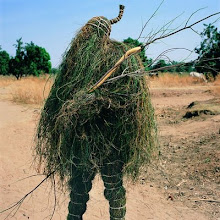April 3, 2011
Bees Can Recognize Faces
If You Swat, Watch Out: Bees Remember Faces
By SINDYA N. BHANOO
Published: February 1, 2010
from The New York Times
A honeybee brain has a million neurons, compared with the 100 billion in a human brain. But, researchers report, bees can recognize faces, and they even do it the same way we do.
Bees and humans both use a technique called configural processing, piecing together the components of a face — eyes, ears, nose and mouth — to form a recognizable pattern, a team of researchers report in the Feb. 15 issue of The Journal of Experimental Biology.
“It’s a kind of gluing,” said Martin Giurfa, a professor of neural biology at the University de Toulouse, France, and one of the study’s authors.
It is the same ability, Dr. Giurfa said, that helps humans realize that a Chinese pagoda and a Swiss chalet are both abodes, based on their components.
“We know two vertical lines, with a hutlike top,” he said. “It’s a house.”
In their research, Dr. Giurfa and his colleagues created a display of hand-drawn images, some faces and some not.
The faces had bowls of sugar water in front of them, while the nonfaces were placed behind bowls containing plain water. After a few failed trips to the bowls without sugar water, the bees kept returning to the sugar-filled bowls in front of the faces, the scientists found.
The images and the bowls were cleaned after every visit, to ensure that the bees were using visual cues to find the sugar and not leaving scent marks.
The researchers found that bees could also distinguish a face that provided sugar water from one that did not.
After several hours’ training, the bees picked the right faces about 75 percent of the time, said Adrian Dyer, another author of the study and a vision scientist at Monash University in Australia.
The researchers said that while they were biologists and not computer scientists, they hoped their work could be more widely used, including by face recognition experts. “If somebody else finds it interesting and it improves airport security, that’s great,” Dr. Dyer said. “The potential mechanisms can be made available to the wider facial recognition community.”
Dr. Giurfa said that the benefit of studying a creature as simple as the bee was in knowing that it did not take a complex neural network to distinguish objects. This could offer hope to technologists, he said.
“We could imagine that through repeat exposure, we may be able to train machines to extract a configuration and know that ‘This a motorbike’ or no, ‘This is rather a dog,’ ” he said.
But while the research on bees is interesting, it does not help with the most difficult problem technologists are having, said David Forsyth, a computer science professor at the University of Illinois, whose research focuses on computer vision.
That challenging problem is to build systems that can recognize the same people over a period of time, Dr. Forsyth said, after their hair has grown, or when they have sunglasses on, or after they have aged. These are all tasks that humans can usually perform but that computers struggle to replicate.
“I highly doubt that bees can tell the difference,” Dr. Forsyth said, adding, “If bees did that, I’d fall off my chair.”
Nonetheless, he said, it is important to add to the body of research on face recognition by studying animals.
While computers have become very capable at detecting faces, dependable face recognition by machines continues to be elusive.
“We know almost nothing about recognition, but it is really useful and really hard, and it helps us make decisions about the world,” Dr. Forsyth said. “Research into anything about identifying and recognizing seems to be a good thing.”
Subscribe to:
Post Comments (Atom)


No comments:
Post a Comment